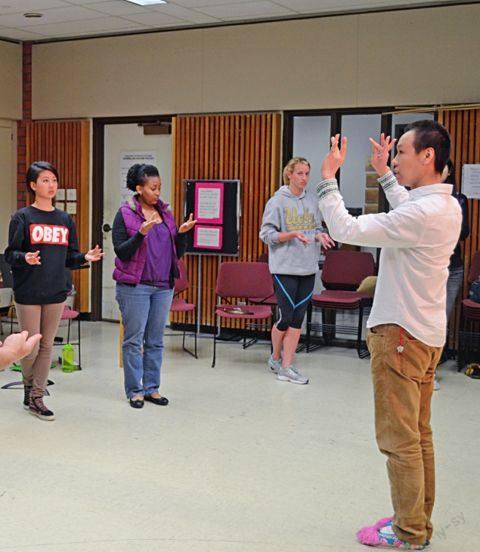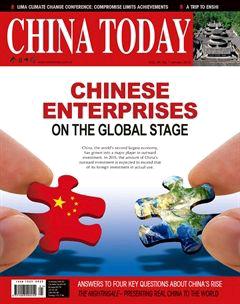Chinese Dramas Prosper in the U.S.
By CHEN QIANQIAN



AS executive director of UCLAs Confucius Institute, Dr. Susan Pertel Jain is proficient in Mandarin and has studied Chinese drama for many years. Through the Confucius Institute, she has devoted herself to researching and spreading Chinese culture.
The Confucius Institute at UCLA spreads Chinese culture through education and academic activities in Chinese language, drama, and cuisine, as well as traditional Chinese medicine.
Key to Understanding Chinese Dramas
Born in America, Susan studied French and Chinese as an undergraduate, and enjoyed music, dance and drama. After graduation, she went to Japan to learn Japanese, music and dance. When applying for postgraduate programs, she considered business or law. Later, she noticed a folk dance program at the University of Hawaii, researching performing arts from the aspect of culture. Eventually she pursued her masters degree at the University of Hawaii, and was introduced to fascinating Asian dramas such as Japanese kabuki, Chinese opera, Indonesian dance and Indian kuttiyattam.
“These are the most interesting things I have ever seen, combining different elements and turning them into part of their countries culture. Sometimes performance arts are just for entertainment, but sometimes they are related to religious rites or politics.”
Thanks to her language advantages Susan won funding for a PhD in Chinese opera.
Susan believes that Asian drama is quite different from Western theater in many elements, including songs, music and distinctive movements. Chinese operas, in particular, often include martial arts. By contrast, Western dramas emphasize the use of language but not the application of body language.
In addition, she says, the storylines of Eastern and Western dramas differ distinctly. According to Susan, modern Western drama audiences usually do not know the plot of the story and are curious to know ending. However, many Asian dramas are analogous to early Western dramas, such as Shakespeares masterpieces. Audiences already know the storyline, and are interested in how performers play the classics.
Performance styles are also very different. Chinese operas have their own rules and are judged by their adherence to this standard. Performers train their voices and body language for many years.“Once you know these rules as well as how players use these specific ‘instruments to affect audiences, then you can appreciate the art. For example, the song played before a ball game in the U.S. is quite touching, and has a special symbolic significance,”said Susan, who holds that Asian dramas seek to integrate fixed art elements and recreate them for spectators. Then the audiences will acknowledge it, even though they already know these elements.“I think it is not impossible for Western audiences to enjoy Chinese dramas. The key lies in teaching them how to appreciate them,” Susan said.
Vitality from Innovation
Although some believe that sticking to tradition is the future of Chinese dramas, other people advocate innovation by adding modern elements.
“What we need is balance. Historically, Chinese operas have always been changing and improving. Once the process stops, it will perish,” Susan said.“Japanese kabuki is an example. Over-protection of kabuki means that no one dares to break from tradition, the art stops innovating and gradually loses its vitality. As a result, many young audiences are not interested in kabuki.”
According to Susan, Chinese operas keep advancing, finding a balance between tradition and modernization. Many traditional theatrical pieces have been well preserved, and there are also many new operas. Some new operas maintain traditional elements, and vice versa. Although innovation is important, Chinese audiences respect tradition and cherish the characteristics of Chinese operas.
“It is the concision of Chinese operas that gives them charm,” said Susan. “Although the props are simple, Chinese operas can be very versatile.” The feature of Sichuan Operas gaoqiang combines an auxiliary chorus, gongs and drums, as well as vocals. The combination can create a beautiful melody. “Jazz music used to be similar, but it has since lost its character by adding string instruments. Although it is worth trying new things, we need to preserve unique features,” Susan said.
Susan appreciates the interaction between new dramas and new audiences. “To follow tradition is to pay respect to the masters. However, even masters want to keep innovating. Sometimes audiences like to see the same old performance, but artists prefer to challenge themselves. Therefore, I think it is great if innovations can resonate among a new generation of viewers,” Susan said.
Integrating with American Culture
Some amateur performers set up performance clubs after migrating to the U.S. As early as the 19th century, immigrant Chinese laborers brought their traditional opera culture to the U.S. Some immigrants funded tours for drama troupes from Guangdong to perform in the U.S., and sometimes amateur performers took the stage as well.
Later, as more Chinese arrived in the U.S., theatrical troupes were established in America. Los Angeles has many troupes performing Cantonese Opera, Peking Opera, Kunqu Opera, and Sichuan Opera. With the help of volunteers, some professional artists came to perform here or even immigrated to the U.S.
Susan and Hua Wenyi, a famous performer of Kunqu Opera, established the first Chinese opera company in America, helping new migrants to perform. “The company gathers professional artists in the U.S. Interestingly, many of them come from the same opera institute or troupe, and know each other well. As a result, it is easy to organize a highlevel performance,” Susan said.
Susan especially likes Kunqu Opera, an artistic form combining singing and dancing, which is a uniquely charming performing art among Chinese operas. Performers can skillfully adapt their facial expressions and body language to express scenes, such as a mountain far away or someone weeping.“These elements in traditional Chinese operas are great. Chinese parents should provide conditions for their children to learn. Moreover, the government should subsidize more projects so that children can learn during their spare time.”
Susan hopes to cooperate more with Hua Wenyi,nyi, as the U.S. government already regards Kunqu Opera as a performance art form.
Part of an Extracurricular Program
Language barriers can hinder communication between Chinese and Western dramas. Susan believes that this problem is not unsolvable. She once watched a Chinese drama about the Generals of the Yang Family when she visited Beijing. The drama tells the story of an old mother whose sons all died in battle, and her daughters and daughters-in-law also had to fight. Although the show was only 40 minutes long, it tells of a complete family tragedy.
Amazed by this performance, Susan translated it into English. When the play was shown in the U.S., some audiences wept for the mothers misfortune.“If it is poorly translated or the audiences do not know how to appreciate the performance, then there wont be such good results,” said Susan, who believes that English translation should reveal the romantic charm of the Chinese original as much as possible. If the Chinese is conveyed as poetry, then the English should adopt the same form. Only in this way can Western audiences have the same experience as Chinese viewers. This is the crux of the challenge.
Susan is sure that an increasing number of U.S. students will learn Chinese dramas. “This is not only because the language is popular in America,”she explained. In addition, the U.S. government has also played a role. The National Security Language Initiative signed by former U.S. President George Bush in 2006 listed a number of recommended languages to boost national development, including Chinese. “This is a good thing, making people aware that it is time for us to learn Chinas culture and language.” Susan knows many Chinese teachers, and many schools contact her to carry out Chinese-language programs. Some teachers are looking for teaching tools for the Chinese language.
One local senior high school opened an extracurricular program. In this project, students learn Chinese as well as erhu, a two-stringed bowed musical instrument, and Kunqu Opera. Although some of these children dont even know much about Western music, they can read the scores and sing arias from Kunqu Opera. “What we need to do is to provide teachers with more Chinese language teaching aids,” Susan said.

